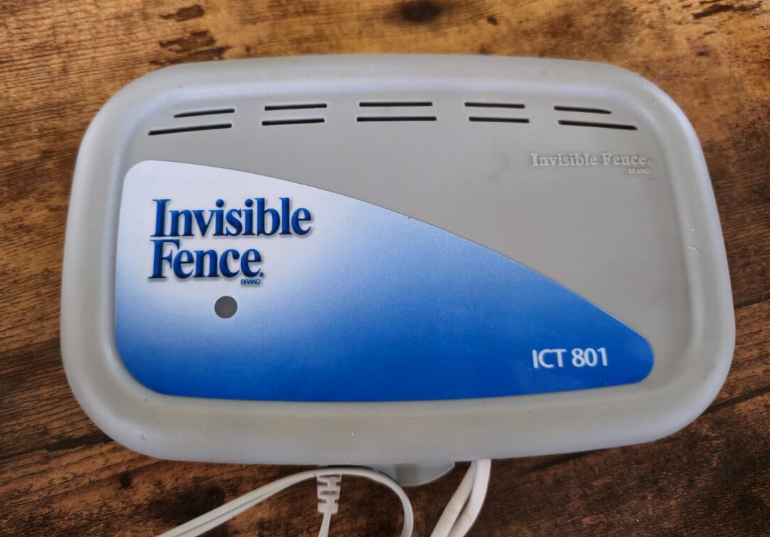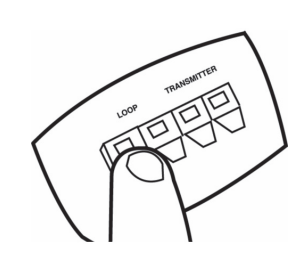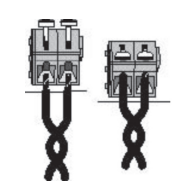
Invisible Fence ICT-801 Transmitter

Planning the Installation
Install the transmitter in a dry indoor location, near a grounded 110VAC electric outlet. Your installation should offer easy access to the outdoors. A garage or basement is usually the best location. If you are not sure the intended outlet is grounded, use a 3-wire circuit analyzer or contact an electrician.
Connecting the Signal Field Wire
All Invisible Fence® Brand Pet Containment Systems must be grounded per the National Electrical Code (NEC) to be protected against lightning. ICT 801 and ICT 802 Transmitters must be installed using the LP-4100 (ICT 801) or LP-4200 (ICT 802) Lightning Protection devices under the NEC and applicable local building codes.
- Strip approximately ¼ inch (6.3mm) of insulation from each end of the signal field wires (in-ground containment loop). Using your finger, depress the tab of one red connector (marked LOOP) on the Lightning Protector. Insert one stripped end of the signal field wire into the red connector hole. Release the tab. Repeat for the remaining signal field wire. Note: Insert only one wire per hole. LP-4100 LP-4200

- Next, connect the ICT 801or ICT 802 transmitter to the LP-4100 or LP-4200 with a short length of twisted pair wire. Strip approximately ¼ inch (6.3mm) of insulation from each end of the twisted pair wires. Insert one of the twisted pair transmitter wires into a black connector hole (marked TRANSMITTER) of the LP-4100 or LP-4200 in the same manner as the signal field wires connected in step #1. Repeat for the remaining twisted pair wire. (Remember — insert only one wire per hole.)

- Connect the other end (stripped the same way as in step #2) of the twisted pair wires to the transmitter via the signal field connectors. Use your thumb to push back on the white tabs
located on top of the signal field wire connectors. While pushing back the tabs, put the end of each wire into each opening of the connectors. Hold the wires steady, and release the tabs.
- Before plugging in the LP-4100 or LP-4200, make sure the electric outlet is properly grounded. Remove the plastic cover protecting the plug on the LP-4100 or LP-4200 and plug it into a grounded 3-prong household outlet (110VAC) within five feet (5’) of where you wish to install the transmitter. When possible, use the center screw that holds the outlet cover plate in place.
If this screw is missing or not long enough, use the longer screw provided with the Lightning Protector. Note: This screw is for mechanical attachment only and does NOT provide an electrical ground! - Plug the transmitter’s AC power adapter into the 3-prong socket in the LP-4100 or LP-4200.
- Install the transmitter base to the wall using four ¾ inch long (19mm), #8, or #10 pan-head sheet metal screws. Insert the screws through the four mounting holes (shown on page 4) in
the base of the transmitter case.
ICT 801 Transmitter

The ICT 801 is a single-loop programmable transmitter designed for installations with up to 3,000 feet of signal field wire and up to 150 feet of twisted pair wire. The ICT 801 has one signal field adjustment
to increase or decrease the width of the signal field. See page 10 for instructions for setting the signal field width.
User Settings and Functions for ICT 801 Transmitter:

- Loop 1: Loop 1 is always functioning on the ICT 801. (No indicator light on the circuit board.)
- L1 Freq: Select either the 7K or 10K signal for Loop 1. The default setting is 7K.
- L1 Signal: Select either Indoor or Outdoor mode for Loop 1. The default setting is Outdoor.
- Mask: Select either Mask or Xmit to transmit a mask or boundary signal for Loop 1. The default setting is Xmit.
- Saturation: When lit, indicates Loop 1 transmitter output saturation. Loop saturation exists when the signal has reached maximum output level, which is caused by excessive loop size, excessive resistance, or poor connections.
- Batt. Fault: When lit, indicates that the 12VDC backup battery is either not installed or not working properly
ICT 802 Transmitter
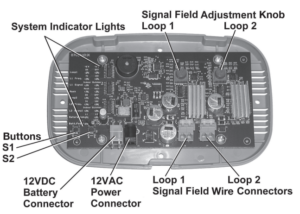
The ICT 802 is a dual-loop programmable transmitter. Each
loop on the ICT 802 can have up to 3,000 feet of loop wire and up to 150 feet of twisted pair. The signal width for each loop can be adjusted by using the signal field adjustments for Loop 1 and Loop 2. See page 10 for instructions for setting the signal field width.
Typical ICT 801 Installation
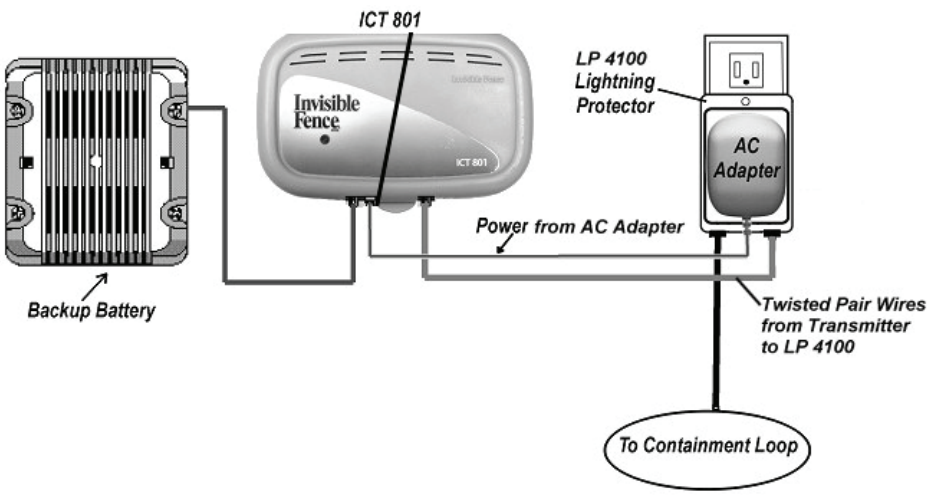
The following requirement applies to installations within the European Community: When using the ICT-801 or the ICT-802 transmitter in the 10KHz transmission mode, the maximum loop area must be no greater than 1,697 square meters. If larger loop size installations are required, the installer is required to use the 7KHz transmission mode in order to comply with the R&TTE regulations.
Typical ICT 802 Installation
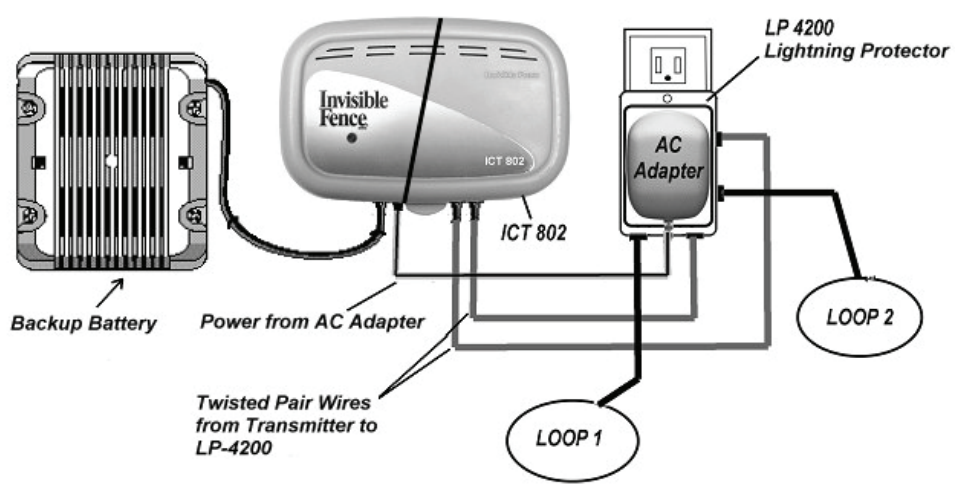
Programming the ICT 801 and ICT 802 Transmitters
On first time power up, the LED system indicator lights will display the following default settings.
Once the transmitter has been programmed, the settings will remain in the system memory. To program the transmitter:
- 1. Press and hold the S1 button for approximately 4 seconds until
- a. For ICT 801: The L1 Freq. The LED begins to blink.
- b. For ICT 802: The Loop 1 LED begins to blink.
- 2. Release the S1 button.
- 3. Momentarily press and release the S2 button to toggle between each setting option.
- 4. Press and release the S1 button to move to the next setting.
- 5. Continue until all choices are selected.
- 6. The cursor LED will stop blinking approximately ten seconds after the buttons are released, and the transmitter will automatically exit the programming mode
LED Status Indicator Light
This is the only visible light from outside of the enclosure when the cover is closed.
Audible Alarm: There is an audible alarm for certain alert conditions (See table below). Press and release either the S1 or the S2 button on the circuit board to silence the alarm. The alarm will re-activate on power-up or when exiting set-up mode (if a failure condition still exists).
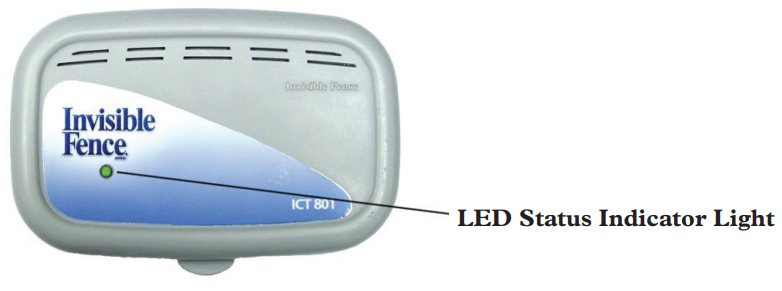

Installing a Backup Battery
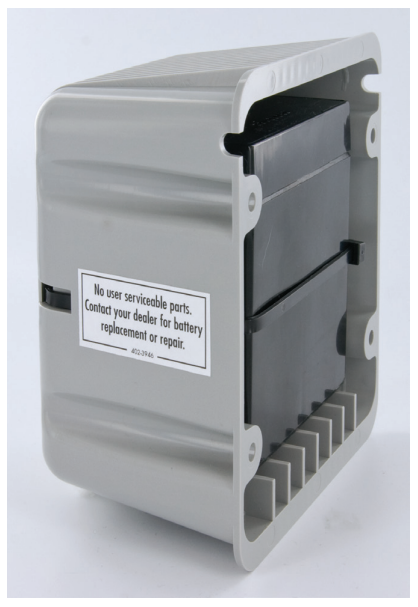
If the system has a backup battery (10-090-0004-01), use an
external battery box (06-900-0207-01)
to hold the battery. Mount the battery box near the transmitter on the same vertical surface that the transmitter is on.
- Hold the battery box on the wall where you are going to mount it. Use the box as a template and mark the position of the 4 screw holes on the wall. Drill 4 small pilot holes in the wall where the screws will go. Insert 4 plastic screw anchors if mounting to drywall.
- Holding the battery box with the open back of the box toward you, lace a 12-inch (30.5cm) zip tie around both of the posts on the inside vertical corners in the front of the battery box. Run the tie around the inside of the box to form a “U”. The “U” turn should be behind the front of the box, and the legs of the “U” should be pointing out toward you.
- Attach the wires to the poles on the battery. CAUTION: DO NOT mix up the RED and BLACK wires when you connect them to the battery. One Red wire, the positive (+) lead, and one Black wire, the negative (-) lead, are used to help eliminate confusion. Connect the spade quick-connect on the RED wire to the positive (+) terminal on the battery. Connect the spade quick-connect on the BLACK wire to the negative (-) battery terminal.
- Put the battery in the box and secure it by pulling the zip tie tight around it.
- Align the battery box with the battery over the pilot holes in the wall, taking care that the wires from the battery are in one of the exit notches on the back edges of the box. Fasten the box to the wall with four 3⁄4 inch, #10 (4.8x19mm) pan-head sheet metal screws.
Setting the Signal Field Width
The signal field is what activates the R21/R22 v4 Computer Collar® unit. The edge of the signal field can be set to various distances from the signal field wire. The distance from the wire loop to the edge of
the signal field is called the signal field width. There is one signal field adjustment knob on the ICT 801 transmitter and two signal field adjustment knobs on the ICT 802 transmitter. See page 5 or 6 as appropriate for the location of signal field adjustment knobs. Turning the signal field adjustment knob clockwise increases the signal field width. Conversely, turning it counter-clockwise decreases the signal field width. Check the width of the signal field from only one place on the signal field loop wire. Always check the signal field width from the same place. Take the Computer Collar® unit off the pet to measure the signal field width.
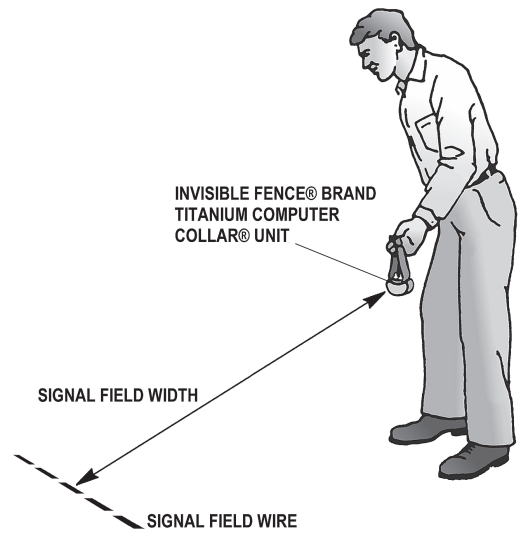
- Hold the Invisible Fence® Brand Computer Collar® unit so it is parallel to the signal field wire.
- Hold the collar so it is about the same height and at the same angle as it will be when the pet is wearing it.
- Walk slowly toward the signal field wire. The unit will activate when you reach the edge of the signal field. Do NOT touch the correction posts at this time!
Setting the Break-Alert® Detection Level:
The Break Alert alarm can be set to activate when the signal field width is reduced by 25% or more of the set signal field width. Read the entire procedure before performing. Only the loops turned on will be programmed.
Option #1: To set the Break Alert to activate when a 25% reduction in the set signal field width occurs:
- Set the signal field width for the desired system operation.
- If battery backup is being used, remove the 12VDC battery power wire harness from transmitter connector J2 (see picture below).
- Remove 12VAC power from transmitter connector J1.
- Press and hold the S2 button while reconnecting the 12VAC power back to the transmitter connector J1.
- Continue holding the S2 button for approximately five more seconds.
- Release the S2 button.
- Break Alert levels are now set. The setting will remain in memory even after power is removed.
- Reconnect the battery backup wire harness to the transmitter connector J2, if applicable.
Option #2: To set the Break Alert to activate at more than a 25% reduction in the set signal field width:
1. Set the initial signal field width to the desired operational signal field width. Note the position of the
indicator on the signal field adjustment knob.
2. Now adjust the signal field width to less than the desired operational signal field width.
3. Complete steps 2 – 6 under Option #1.
4. Adjust the signal field width to the desired operational field width.
5. Break Alert levels are now set. The setting will remain in memory even after power is removed.
Option #3: To set the Break Alert level back to the default settings (less than 1 foot).
- Set the signal field width to the lowest setting (turn signal field adjustment all the way counterclockwise).
- Complete steps 2 – 6 under Option #1
- Set the signal field width to the desired operational field width.
- Break Alert levels are now set. The setting will remain in memory even after power is removed.
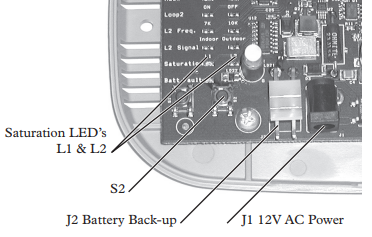
R21/R22 v4 Computer Collar® Unit
Invisible Fence® Brand Computer Collar® units are microprocessor-controlled units powered by a Power Cap® unit.
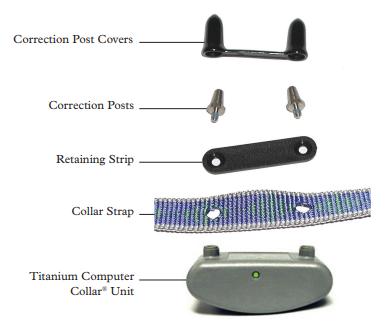
Fitting the Invisible Fence® Brand Computer Collar® Unit:
To work properly, the correction posts on the Invisible Fence® Brand Computer Collar® unit must touch the pet’s skin.
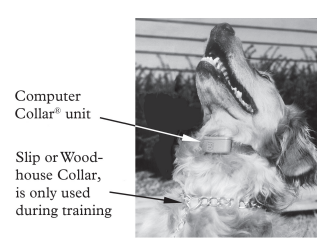
- Position the collar strap unit high on the pet’s neck with the Computer Collar® unit under its lower jaw.
- To avoid having a collar that is too tight on a thick-haired pet, trim some hair away to make skin contact with the correction posts. DO NOT shave the pet’s neck.
- Tighten the strap of the Invisible Fence® Brand Computer Collar® unit appropriately. Adjust the collar so it is snug enough to slide one finger between the correction post and the pet’s skin.
- The fit of the Invisible Fence® Brand Computer Collar® unit should be adjusted as necessary as the pet’s coat, weight, and age change. The pet’s coat may change from season to season.
- Allow the pet to become accustomed to its new Invisible Fence® Brand Computer Collar® unit. The collar should be removed each night during the first month of training and regularly thereafter. This ensures proper fit and avoids the possibility of skin irritation from the correction posts.
Invisible Fence® Brand R21/R22 v4 Computer Collar® Unit Power Cap® Unit Status: The ICT 800 Series Transmitters utilize the R21/R22 v4 Computer Collar® unit. This Computer Collar® unit monitors the Power Cap® unit status and will alert the owner when the Power Cap® unit needs to be replaced. A Power Cap® unit test is performed each time it is inserted into the Computer Collar® unit.

When the Power Cap® unit is inserted, the LED Status Indicator shows a GREEN light for up to 1 second while testing. After that, you will see 4 blinks in one of the following colors, indicating the Power
Cap® unit status:
- GREEN = Power Cap® unit is good.
- YELLOW (4.1 & 4.2 only) = The Power Cap® unit is low. Replace as soon as possible.
- RED = The Power Cap® unit is dead. Replace immediately. Do not rely on the Invisible Fence® Brand pet containment system to contain the pet until the Power Cap® unit is replaced.
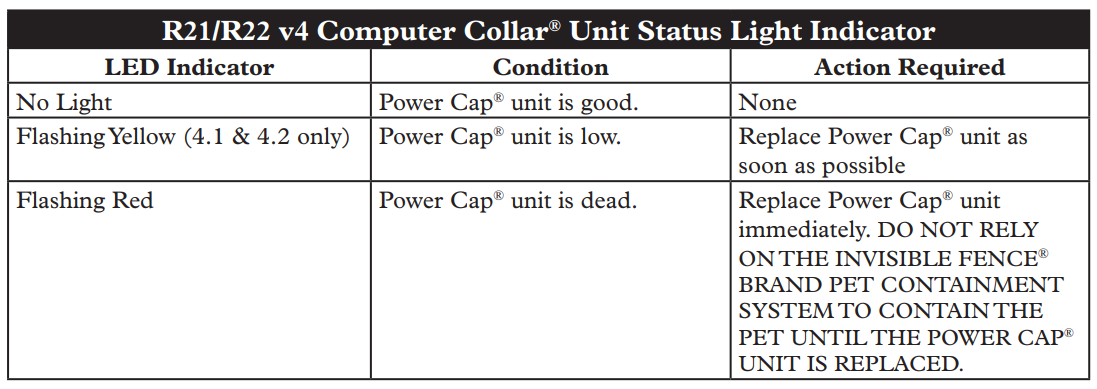
Changing the Power Cap® Unit:
- Use a small, thin coin to remove the Power Cap® unit from the R21/R22 v4 Computer Collar® unit. Insert the coin in the slot on top of the Power Cap® unit and turn it counter-clockwise. Do not push down while turning. The Power Cap® unit will rotate up and out of the R21/R22 v4 Computer Collar® unit’s battery chamber.
- Line up the lugs on each side of the bottom of the new Power Cap® unit with the grooves in the sides of the R21/R22 v4 Computer Collar® unit’s battery chamber. Make sure the metal tabs on the bottom of the Power Cap® unit are not bent.
- Place the Power Cap® unit into the chamber while gently, but firmly, turning it clockwise with your fingers.
- Use a small, thin coin in the slot on top of the Power Cap® unit to turn it clockwise until the slot on the top of the Power Cap® unit is lined up with the two small raised tabs on the bottom of the receiver. Do not over-tighten by turning the slot past the tabs on the receiver.
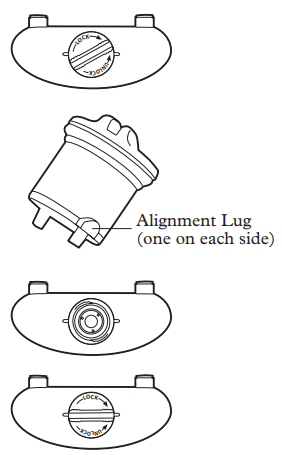
FOR MORE MANUALS BY INVISIBLE FENCE, VISIT MANUALSLIBRARYY
Invisible Fence ICT-801 Transmitter-FAQs
How much power does the system use?
About 5 watts (like a nightlight)—costs ~$10/year in electricity.
Why is my transmitter beeping?
A continuous beep means a wire break. Walk the boundary to find and repair the break.
How do I test if the fence is working?
Use the collar’s test light tool (if included).
Hold the collar near the boundary—it should beep and correct.
How deep should I bury the wire?
3–5 inches deep—use a trencher for easier installation.
Can I move my Invisible Fence?
Yes! You’ll need to rebury the wire in the new location and retrain your pet.
How long does the shock last?
The static correction lasts up to 15 seconds after crossing the boundary.
What does a blinking blue light mean?
(GPS models only) The base unit is trying to connect to WiFi. Check your network settings.
Can I use an Invisible Fence with GPS?
Yes, Invisible Fence® GPS Collars offer wire-free boundaries via GPS tracking (requires a subscription).
What voltage is the correction?
The collar delivers a 3V static pulse (similar to a TENS unit).

